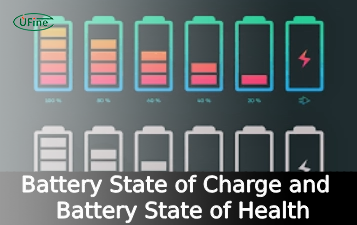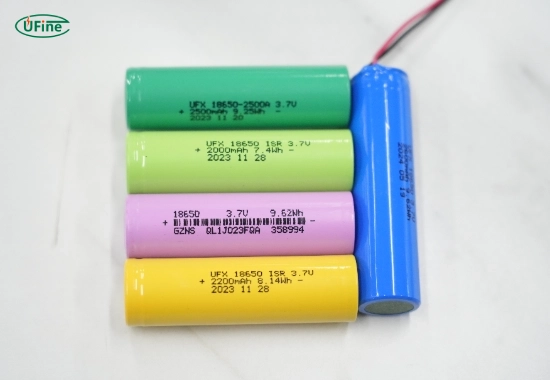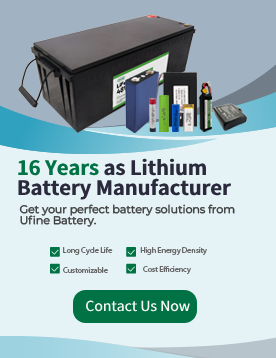
- Part 1. What is a pencil battery?
- Part 2. Why do batteries come in different sizes?
- Part 3. What is the difference between AA and AAA batteries?
- Part 4. What are the most common pencil battery sizes?
- Part 5. What is an 18650 battery and why is it important?
- Part 6. How do I choose the right pencil battery for my device?
- Part 7. What does battery chemistry mean and why does it matter?
- Part 8. Can I mix different types of batteries?
- Part 9. What does mAh mean and why is it important?
- Part 10. Are rechargeable pencil batteries better than disposable ones?
- Part 11. Advantages of 18650 batteries for modern electronics
- Part 12. FAQs about pencil battery
Looking for the right pencil battery for your device? This detailed guide explains everything about AA, AAA, and other cylindrical battery sizes, including the powerful 18650 lithium battery. Whether you need batteries for toys, flashlights, or electronics, this article helps you understand battery types, sizes, and uses with clarity and precision.
Part 1. What is a pencil battery?
A pencil battery is a common name used to describe cylindrical batteries that are slim and round, similar in shape to a pencil. The most typical examples are AA and AAA batteries, but the term can also refer to other cylindrical cells such as C, D, and 18650 batteries.
These batteries are widely used in household electronics, remote controls, LED lights, clocks, and even high-energy devices like laptops and flashlights when using batteries like the 18650.
Part 2. Why do batteries come in different sizes?
Batteries are designed in different sizes to match the power requirements and physical dimensions of various devices.
- Smaller devices like TV remotes or thermometers need compact batteries such as AAA.
- Medium-sized devices such as wireless mice or toys often use AA batteries.
- High-drain devices like powerful flashlights or portable speakers may use larger batteries like C, D, or 18650 cells.
Each size provides a balance between capacity, voltage, and fit. Choosing the correct size ensures your device works efficiently and safely.
Part 3. What is the difference between AA and AAA batteries?
Both AA and AAA batteries are 1.5-volt cylindrical batteries, but they differ in size and capacity.
| Feature | AA Battery | AAA Battery |
|---|---|---|
| Length | 50.5 mm | 44.5 mm |
| Diameter | 14.5 mm | 10.5 mm |
| Capacity | 1800 to 3000 mAh | 600 to 1200 mAh |
| Common Uses | Toys, flashlights, remotes | Clocks, small remotes, thermometers |
Because AA batteries are larger, they hold more energy and are suited for devices that require more power. AAA batteries are lighter and best for small, low-drain devices.
Part 4. What are the most common pencil battery sizes?
Here are the most frequently used cylindrical battery sizes:
- AAA (Triple-A): Used in compact, low-power devices like clocks, mini flashlights, and TV remotes.
- AA (Double-A): Found in toys, wireless keyboards, cameras, and gaming controllers.
- C Cell: Larger than AA, used in radios, lanterns, and some musical toys.
- D Cell: Thicker and heavier, ideal for boomboxes, high-powered flashlights, and emergency lights.
- 18650 Cell: A high-performance lithium-ion battery commonly used in flashlights, power tools, laptops, and electric vehicles.
Each battery has a unique size, energy capacity, and voltage level. Understanding these differences helps in choosing the right one for your needs.
Part 5. What is an 18650 battery and why is it important?
The 18650 battery is a rechargeable lithium-ion battery widely used in high-performance devices. Its name refers to its size: 18 mm in diameter and 65 mm in length.
Key features of 18650 batteries:
- Voltage: Typically 3.6 or 3.7 volts
- Capacity: Ranges from 2000 to 3500 mAh
- Rechargeable: Can be recharged hundreds of times
- High energy density: Ideal for devices that demand stable and long-lasting power
Common uses of 18650 batteries:
- High-lumen LED flashlights
- Laptop battery packs
- Electric bikes and scooters
- Portable power stations
- Vape devices
- Solar energy storage
As a lithium battery manufacturer, we recommend 18650 cells for applications that need reliable, rechargeable, and long-lasting power. They are more efficient and environmentally friendly compared to disposable alkaline batteries.
Part 6. How do I choose the right pencil battery for my device?
To choose the right pencil battery for your device, follow these simple steps:
- Check the battery size required
Look at the battery compartment or manual. It will tell you the exact size such as AA, AAA, or 18650. - Match the voltage
Most AA and AAA batteries provide 1.5 volts. Rechargeable versions often give 1.2 volts, which is still compatible with most devices. 18650 batteries provide higher voltage, usually 3.6 or 3.7 volts. - Understand your device’s power needs
If your device is a high-drain product like a digital camera or flashlight, use batteries with a higher mAh rating or choose lithium or NiMH types. - Decide between disposable or rechargeable
If your device is used daily, invest in rechargeable batteries. For occasional use, alkaline batteries may be more convenient. - Choose the right battery chemistry
Use alkaline for general use, NiMH for reusable options, and lithium-ion like 18650 for high-power or long-lasting performance.
These steps help ensure your device runs safely, efficiently, and for longer periods without frequent replacements.
Part 7. What does battery chemistry mean and why does it matter?
Battery chemistry refers to the materials and reactions used to store and release energy. Different chemistries affect power output, shelf life, and cost.
Common battery chemistries in pencil batteries:
- Alkaline: Most common and affordable. Good for remote controls and toys.
- Lithium (Primary): Lightweight and long-lasting. Performs well in extreme temperatures.
- Lithium-Ion (Rechargeable): High capacity and efficiency. Used in 18650 cells and electronics.
- Nickel-Metal Hydride (NiMH): Rechargeable and eco-friendly. Suitable for AA and AAA sizes.
- Zinc-Carbon: Inexpensive but less powerful. Suitable for low-drain devices.
Choosing the right chemistry improves device performance and can reduce long-term costs.
Part 8. Can I mix different types of batteries?
No, you should never mix different battery types in the same device. This includes:
- Mixing different sizes or shapes
- Mixing new and old batteries
- Combining rechargeable and disposable batteries
- Using batteries from different brands
Doing so can lead to leakage, overheating, or device damage. Always use the same type, brand, and age of batteries together.
Part 9. What does mAh mean and why is it important?
mAh stands for milliampere-hour, a measure of how much energy a battery can store.
- Higher mAh means the battery can power a device for longer
- Lower mAh means shorter usage time between recharges or replacements
For example, a 3000 mAh 18650 battery will last longer than a 2000 mAh version, assuming the same device is used.
Always match the mAh rating to the power needs of your device. For high-drain gadgets, aim for higher capacity batteries.
Part 10. Are rechargeable pencil batteries better than disposable ones?
Yes, rechargeable pencil batteries offer long-term value and are better for the environment. They can be used hundreds of times, reducing waste and saving money.
Benefits of rechargeable batteries:
- Cost-effective over time
- Eco-friendly with less waste
- High power output for demanding devices
- Ideal for daily-use items like cameras, game controllers, and flashlights
If your device supports rechargeable batteries, NiMH and 18650 lithium cells are excellent options.
Part 11. Advantages of 18650 batteries for modern electronics
As a lithium battery manufacturer, we recognize the growing popularity of the 18650 cell. Its high energy density, stable performance, and rechargeability make it the top choice for many industries.
Why choose 18650 batteries?
- Longer cycle life than most AA or AAA rechargeable batteries
- More power per charge
- Compact size compared to total power output
- Built-in protection circuits in many models
18650 batteries are the future of portable power. Whether for flashlights, electric bikes, or solar storage systems, they deliver both power and reliability.
Part 12. FAQs about pencil battery
What is the most common pencil battery size?
The most common size is the AA battery, widely used in household electronics.
Can I use AAA instead of AA batteries?
No, AAA batteries are smaller and not compatible with devices that require AA. Always use the correct size specified.
Are all AA batteries the same?
No. While they have the same size, they can differ in chemistry, capacity, and quality. Always choose based on performance needs.
How long does a 18650 battery last?
A typical 18650 battery can last 300 to 500 charge cycles, and up to 2 to 3 years depending on usage and storage.
Are lithium batteries better than alkaline?
Yes. Lithium batteries last longer, perform better in cold temperatures, and are more suited for high-drain devices than alkalines.
Related Tags:
More Articles

Battery State of Charge and Battery State of Health
Battery SoC vs. SoH explained: Learn professional methods to measure charge levels, test health status, and optimize battery performance for longer lifespan.
Difference Between 18650, 26650, and 21700 Batteries
What’s the difference between 18650, 21700, and 26650 batteries? Compare size, capacity, and performance to find the best lithium battery for your device.
LFP Battery Vs. LTO Battery: A Detailed Comparison
Compare LFP (LiFePO4) and LTO (Lithium Titanate) batteries by energy density, lifespan, safety, cost, and uses in EVs, solar storage, and backup power.
Compare 18650 battery types: Li-ion, LiFePO4, and LiPo. Key specs (voltage/capacity) and best uses for vapes, flashlights, EV batteries.
How to Distinguish Between Grade A, Grade B, and Grade C LiFePO4 cells?
Explore the differences between Grade A, B, and C LiFePO4 cells and learn how to choose the right one for electric vehicles, solar storage, or backup power.




